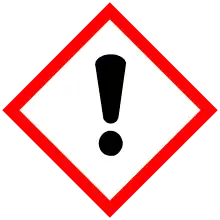Neodymium(II) iodide
Neodymium(II) iodide or neodymium diiodide is an inorganic salt of iodine and neodymium the formula NdI2. Neodymium uses the +2 oxidation state in the compound.
| Names | |
|---|---|
| IUPAC name
Diiodoneodymium | |
| Other names
Neodymium diiodide | |
| Identifiers | |
3D model (JSmol) |
|
| ECHA InfoCard | 100.150.931 |
| EC Number |
|
PubChem CID |
|
CompTox Dashboard (EPA) |
|
| |
| |
| Properties | |
| NdI2 | |
| Molar mass | 398.05 |
| Hazards | |
| GHS labelling: | |
 [1] [1] | |
| Warning[1] | |
| Related compounds | |
Other anions |
Neodymium acetate, Neodymium hydride, Neodymium nickelate |
Other cations |
samarium iodide, lanthanum iodide, europium iodide |
Except where otherwise noted, data are given for materials in their standard state (at 25 °C [77 °F], 100 kPa).
Infobox references | |
Formation
Neodymium(II) iodide can be made by heating molten neodymium(III) iodide with neodymium metal at 800 and 580°C for 12 hours.[2]
Properties
Neodymium(II) iodide is not stoichiometric, and has a formula of closer to NdI1.95.[2] Neodymium(II) iodide melts at 562°C.[3] It is a violet compound.
Neodymium(II) iodide is an electrical insulator.[2]
Reactions
Neodymium(II) iodide reacts with organohalides by extracting the halogen, resulting in dimers, oligomers or reactions with the solvent.[4]
Solvates are known with tetrahydrofuran and dimethoxyethane: NdI2(THF)2 and NdI2(DME)2[5]
Neodymium(II) iodide reduces hot nitrogen to form an iodide nitride: (NdI2)3N which with THF also gives (NdI)3N2.[6]
It reacts with cyclopentadiene in THF to give CpNdI2(THF)3.[7]
See also
References
- See https://pubchem.ncbi.nlm.nih.gov/compound/Neodymium_II_-iodide
- Sallach, Robert A.; Corbett, John D. (July 1964). "Magnetic Susceptibilities of Neodymium (II) Chloride and Iodide". Inorganic Chemistry. 3 (7): 993–995. doi:10.1021/ic50017a015.
- Druding, Leonard F.; Corbett, John D. (June 1961). "Lower Oxidation States of the Lanthanides. Neodymium(II) Chloride and Iodide 1". Journal of the American Chemical Society. 83 (11): 2462–2467. doi:10.1021/ja01472a010.
- Fagin, Anatolii A.; Balashova, Tatyana V.; Kusyaev, Dmitrii M.; Kulikova, Tatyana I.; Glukhova, Tatyana A.; Makarenko, Natalya P.; Kurskii, Yurii A.; Evans, William J.; Bochkarev, Mikhail N. (March 2006). "Reactions of neodymium(II) iodide with organohalides". Polyhedron. 25 (5): 1105–1110. doi:10.1016/j.poly.2005.08.050.
- Bochkarev, Mikhail N.; Fagin, Anatolii A. (24 September 1999). "A New Route to Neodymium(II) and Dysprosium(II) Iodides". Chemistry a European Journal. 5 (10): 2990–2992. doi:10.1002/(SICI)1521-3765(19991001)5:10<2990::AID-CHEM2990>3.0.CO;2-U.
- Fagin, A. A.; Salmova, S. V.; Bochkarev, M. N. (January 2009). "Reduction of nitrogen with neodymium(II) and dysprosium(II) diiodides and selected properties of the resulting nitrides". Russian Chemical Bulletin. 58 (1): 230–233. doi:10.1007/s11172-009-0034-2. S2CID 98798042.
- Khoroshen'kov, G. V.; Fag, A. A.; Bochkarev, M. N.; Dechert, S.; Schumann, H. (1 August 2003). "Reactions of neodymium(ii), dysprosium(ii), and thulium(ii) diiodides with cyclopentadiene. Molecular structures of complexes CpTmI2(THF)3 and [NdI2(THF)5]+[NdI4(THF)2]–". Russian Chemical Bulletin. 52 (8): 1715–1719. doi:10.1023/A:1026132017155. S2CID 91646257.